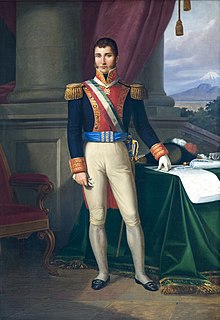Treaty of Cordoba
The Treaty of Cordoba between the leader of the Mexican independence movement Agustín de Iturbide and the last Spanish viceroy Juan O'Donojú of August 24, 1821 formed the legal basis for the development of the first Mexican empire . It was not recognized by the Spanish government until 1836.
prehistory
Since 1810, Mexican troops have been in a war of independence with the Spanish colonial power . In 1821 the Mexican independence fighters controlled all of Mexico with the exception of the cities of Acapulco , Mexico City and Veracruz .
On July 30th, Juan de O'Donojú, appointed by the Spanish government as the "Supreme Director of the Colony" ( jefe político superior ), arrived in Veracruz. Contrary to what was announced before his appointment, he found only a few loyal troops there. In view of his own military inferiority, he proposed iturbide to meet in Cordoba , where both arrived on August 23, 1821.
The content of the contract
On August 24, both sides signed the “Tratado de Córdoba”. O'Donojú was not authorized to do this by the Spanish government. The contract was based on the Iguala plan and consisted of 17 articles. In essence, he saw the independence of Mexico as a moderate constitutional monarchy under a Spanish monarch ( Ferdinand VII , or - if the latter refused - his brothers Carlos or Francisco ). In the event that Spain refused to take over the throne, the Regency Council to be set up should appoint a monarch. This nine-person body included Iturbide and O'Donojú.
Iturbide was to rule Mexico as President of the Regency Council and Commander-in-Chief and O'Donojú resigned as Viceroy. On September 23, the Regency Council was formally installed and Mexico's independence was proclaimed in Mexico City. The Spanish garrison that remained there surrendered in view of the authority of O'Donojús.
Further development
On February 13, 1822, the Spanish court rejected the contract. Out of consideration for the continuing claims of Spain, no European royal house accepted the Mexican offer to the throne. Therefore, Iturbide was elected Emperor on May 19, 1822 by the Regency Council. On July 21, 1822 he was enthroned as August I. His impending overthrow as a result of his uncompromising reign he anticipated by voluntarily abdicating on March 19, 1823, and Mexico became a republic. Spanish troops occupied a fort on San Juan de Ulúa near Veracruz until 1825 . Spain attempted invasions again in 1827 and 1829, but they failed. Only in 1836 did Spain recognize Mexico's independence.
Web links
- Tratados de Cordoba - contract text (Spanish, PDF, 11 KiB)
Individual evidence
- ↑ a b Cf. Nettie Lee Benson: The provincial deputation in Mexico: harbinger of provincial autonomy, independence and federalism , Austin 1992, pp. 40f.
- ↑ See Leslie Bethell: The Cambridge history of Latin America , Vol. 3, Cambridge 2002, p. 88.
- ↑ See Michael S. Werner: Concise encyclopedia of Mexico , Chicago 2001, p. 309.
- ↑ See Peter John Bakewell: A history of Latin America: 1450 to the present , Oxford 2004, p. 404.
- ↑ See Lee Stacy: Mexico and the United States , New York 2003, p. 431.

